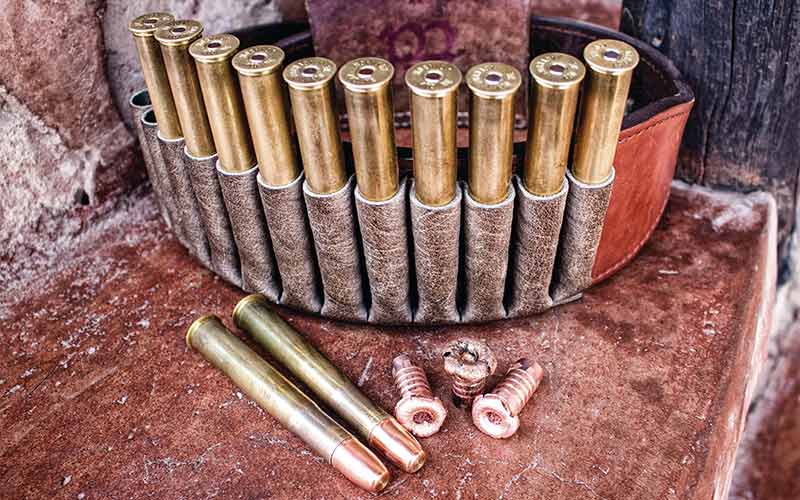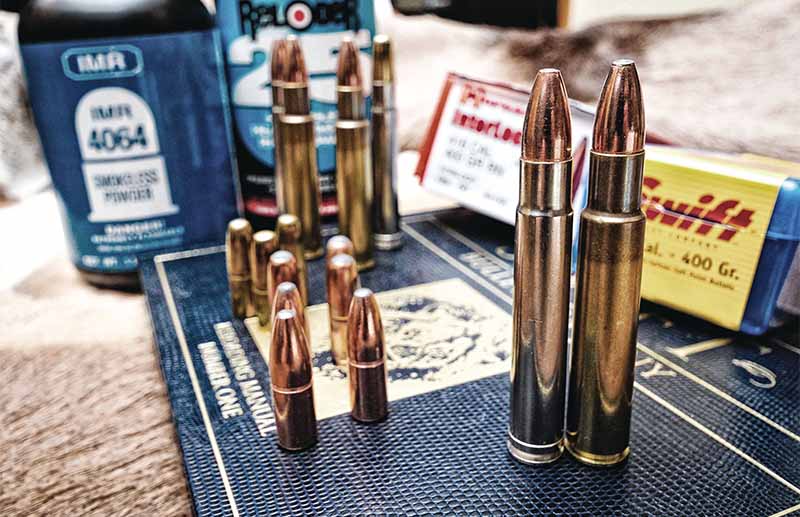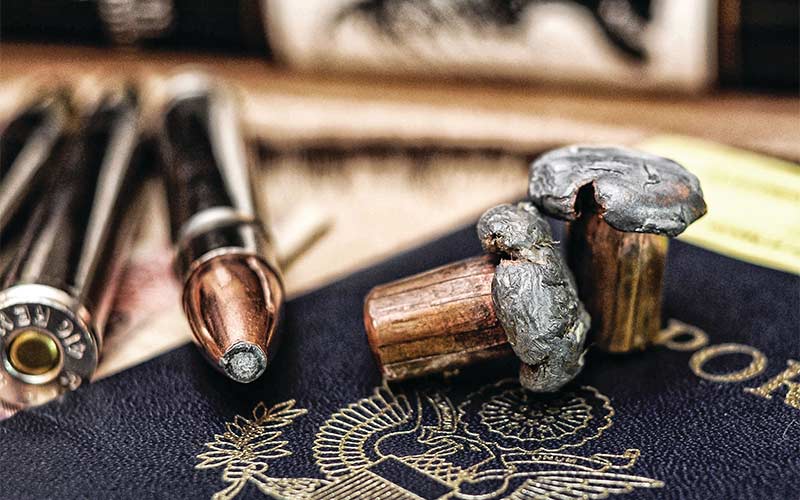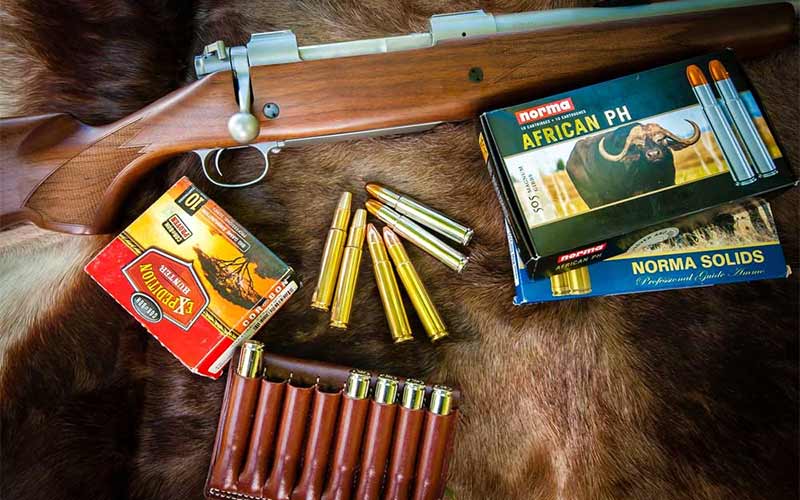
Reloading big-bore cartridges from .416 Rigby to .505 Gibbs.
The big-bore cartridges have such a wide variation in design, construction and birth dates that it requires a bit of examination to best understand how to approach them as a handloader. For example, the .416 Rigby dates from 1911, the revered .375 H&H from 1912, the .470 NE from 1907, the .458 Winchester Magnum from 1956, the .416 Remington Magnum from 1988 and the .450 Rigby from 1994. Spanning the majority of the 20th century, these cartridges saw the transition from cordite to smokeless powder as the propellant du jour, yet the geometry and pressure levels of these cartridges vary greatly.

The .416 Family
Looking at the .416 Rigby, a proprietary design in both cartridge and bore diameter, it remains a popular choice to this day based on field performance, nostalgia and quite a bit of adoration from Robert Ruark.
The .416 Remington Magnum is based in the belted H&H case and mirrors the ballistics of the much-older Rigby, in a smaller package, albeit at a higher pressure. That pressure—in the Remington Model 700—nearly cost the .416 Remington its life. With the powders available three-plus decades ago, excessive pressure posed a real issue in the hottest parts of Africa. Simply put, the Model 700 action couldn’t reliably extract the cartridge in the 120-degree temperatures of areas. Thankfully, a good number of folks tried the .416 Remington in controlled-round-feed actions and saw the wisdom of using it as an all-around African game cartridge, as well as an Alaskan brown bear cartridge.
If, quite like yours truly, the cost of these big cartridges plays a role in selecting which you’ll be purchasing and using, you’ll see a savings in factory ammunition when buying the .416 Remington Magnum or .416 Ruger in comparison to the .416 Rigby. You’ll also see the former pair of young upstarts are far more economical in the powder department, not to mention the cost of new brass cases. All three share ballistics so similar that no target will ever know the difference.

Though the pressures are undoubtedly higher in the younger cartridges, I’ve always found the Rigby case offers a higher level of recoil—probably due to having to burn a considerable volume of powder to attain the same volume in the larger case—when all three are delivering the 400-grain bullets at 2,400 fps. I chose the .416 Remington Magnum; it gave that 2,400 fps without pushing the pressure boundaries too far with a load of 78.0 grains of IMR4064 sparked by a large-rifle magnum primer and pushing a 400-grain bullet. I’ve had no issues with high pressures or sticky extraction in my Winchester 70.
Some may make the case that the oversized Rigby case is easily capable of exceeding 2,500 or even 2,600 fps with a 400-grain bullet. While this is a true and valid statement, I also know I don’t need to drive a 400-grain bullet any faster than 2,400 fps to take any game animal, anywhere. In fact, I’ve found that the 2,275- to 2,300-fps range offers the same killing power but is much easier on the shoulder.

The .458 Family
The .458s remain a popular choice, with John Rigby’s 1898-designed .450 NE being the benchmark for performance at driving a 480-grain bullet to 2,150 fps. The big-rimmed cartridge was a huge success; however, the British ban on .45-caliber ammunition in the Sudan as well as India gave rise to the .470 Nitro Express, .475 Nitro Express and many more, which would greatly diminish the .450’s popularity.
Winchester used a shortened, belted H&H case to develop their .458 Winchester Magnum in 1956 to mimic the .450 NE’s ballistics, albeit with a 510-grain bullet. However, it didn’t measure up. The velocities rarely exceeded 2,000 fps, sometimes far less, and penetration issues soon reared their ugly head.

Modern ammunition for the .458 Winchester seems to have been corrected, and handloaders have a few powders at their disposal—namely Hodgdon’s H335 and Accurate 2230—which can help give the proper velocities without being overly compressed. Those who prefer the longer Lott case—and I see nothing wrong with choosing it—can get to 2,150 or 2,200 fps without much effort. The 0.300-inch case extension also gives the reloader a bunch more room, helping to avoid over-compression of the powder charge. While I definitely like the ball powders in the .458 Winchester, as they maximize the limited real estate, the .458 Lott is happy to be loaded with powders like Hodgdon’s Varget, IMR4166 or IMR4064, and I’ve had great results with that case pushing a 500-grain bullet at 2,200 fps or so.
Going Really Big-Bore
Looking into the bigger cases, the .470 Nitro Express has become one of my personal favorites in a Heym Model 89B double. The big, 3¼-inch case has all sorts of capacity, though, like the .416 Rigby, you really don’t need to use it all. While I had both accuracy and proper velocity using H4831SC and a 500-grain bullet (double rifles are regulated for a specific bullet weight/velocity), I got the same ballistics when using a charge of Reloder 15 compressed by a Kynoch foam wad, although the recoil dropped off considerably. My rifle loves 88.0 grains of RL-15 with that wad and several different 500-grain slugs, including the Federal Trophy Bonded Bear Claw softpoint and Sledgehammer Solids, Peregrine BushMasters, Swift A-Frames, Barnes TSX and Banded Solid, and Hornady’s duo of DGX Bonded and DGS solids.

Based on the success of the .470 NE with the Kynoch foam wad, I tried it with a .505 Gibbs, and the same rule applied to that soul-crushing cartridge. I got the velocity I was after, using a 525-grain Barnes TSX softpoint and Woodleigh Hydro Solid at a significantly reduced recoil level.
The point here is that reloading for the big-bore cartridges can truly change the way you view and feel about one of these intimidating thumpers, and it will definitely affect how you shoot the classics. The factory loads might be suitable, but I like the customized effect of handloading when it comes to these big-bores.
Editor's Note: This article originally appeared in the May 2021 issue of Gun Digest the Magazine.
Get More Reloading Info:
- Tips For Reloading the .30-06 Springfield
- Loving Your Luger: Reloading the 9mm Luger
- Handloading: Tips For Reloading The 7mm Rem Mag
- How To: Tips For Reloading the .223 Remington
- Reloading Bench: The Inside On Reloading For The .30-30 Winchester

Next Step: Get your FREE Printable Target Pack
Enhance your shooting precision with our 62 MOA Targets, perfect for rifles and handguns. Crafted in collaboration with Storm Tactical for accuracy and versatility.
Subscribe to the Gun Digest email newsletter and get your downloadable target pack sent straight to your inbox. Stay updated with the latest firearms info in the industry.

![Best Concealed Carry Guns In 2025 [Field Tested] Wilson Combat EDC X9S 1](https://gundigest.com/wp-content/uploads/Wilson-Combat-EDC-X9S-1-324x160.jpg)


![Best 9mm Carbine: Affordable PCCs [Tested] Ruger Carbine Shooting](https://gundigest.com/wp-content/uploads/Ruger-Carbine-Shooting-100x70.jpg)
![Best AR-15: Top Options Available Today [Field Tested] Harrington and Richardson PSA XM177E2 feature](https://gundigest.com/wp-content/uploads/Harrington-and-Richardson-PSA-XM177E2-feature-100x70.jpg)
